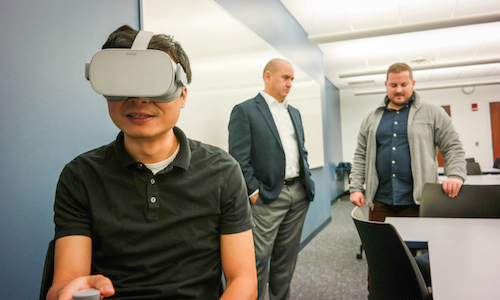
As a professor of education, UM-Dearborn’s David Hill makes a practice of keeping up on the latest educational technologies. As a former special education teacher, he’s also highly aware that students with disabilities are often overlooked in how tech is deployed in classrooms. He seems to always be working hard to reverse that trend. A few years back, his MCubed collaboration with Professor of Educational Technology Stein Brunvand and Associate Professor of Mathematics Mahesh Agarwal yielded a pilot STEM coding curriculum for special education classrooms. Now, Hill and Brunvand are back at it with a new MCubed project that’s exploring the potential of virtual reality for students with disabilities.
Hill describes their latest effort as a riff on a proven analog tool in the special education toolbox. Known as community-based instruction (CBI), it involves getting students outside the classroom and into the community, where they can practice life skills like shopping or riding public transit. “It’s very effective, but it’s also very labor intensive and therefore costly,” Hill explains. “Typically, you have to pay for a school bus to take the kids to a location. And if you have a group of 15 students, who all have very specific needs, you need a team of teachers and paraprofessionals to go along. In an era of budget cuts, that’s a hard expense to justify for many schools.”
Inspired by virtual reality applications for kids with autism, Hill began thinking about whether VR could provide a useful, less-expensive version of the community-based experience. Inside a virtual grocery store, for example, kids could use VR to practice using a shopping list or going through the checkout line. Brunvand and Hill even thought virtual environments might offer some advantages over the real world. If the experience became too intense for a student, for example, you could simply hit the pause button. A VR simulation could also be repeated multiple times with no additional cost. Brunvand says you could even “scaffold” the experience, so that students are mastering the easier parts first, and then gradually working up to more difficult ones.
That was the basic idea, but Hill and Brunvand needed a little help to pull off a project involving so much advanced tech. Industrial and Manufacturing Systems Engineering Assistant Professor Feng Zhou and UM-Flint Assistant Professor of Education Benjamin Emihovich are stepping up on that front. Zhou, who’s an expert in eye tracking and other physiological measures for interactive technologies, helped the team select the 360-degree cameras and software they’d need. And Emihovich, who brings expertise in educational gaming, is contributing big on the assessment end. In particular, he’s helping to ensure the game design provides the appropriate level of difficulty and allows the team to zero in on the research questions they're most interested in.
Despite so many moving parts, the team has made a lot of progress. Right now, their UM-Dearborn undergraduate assistant, Robert Larabell, is busy stitching together their pilot footage and adding finishing touches like footprints to guide the students’ VR experience. Shot inside a real grocery store, the simulation will let them do many of the things they could in the real world — including walking down aisles, selecting items from the shelves using a handheld VR controller, adding things to a shopping cart, and going through the self-checkout. (Special thanks, by the way, to Hill and Brunvand’s neighborhood Kroger in Canton, which championed their cause and made the filming possible.)
Hill and Brunvand say if eventual beta tests are successful, next steps include designing a classroom curriculum for the technology and recruiting special education teachers to demo it with their students. After that, if it proves to be a useful tool, they hope to expand their menu of virtual experiences to things like movie theaters and public transportation. Zhou says further down the line, they could even add physiological measures to help quantify just how good a substitute their VR world is for the real thing.
###
Partial funding for this project is provided through a UM-Dearborn Scholars grant from the Office of Research and Sponsored Programs.




